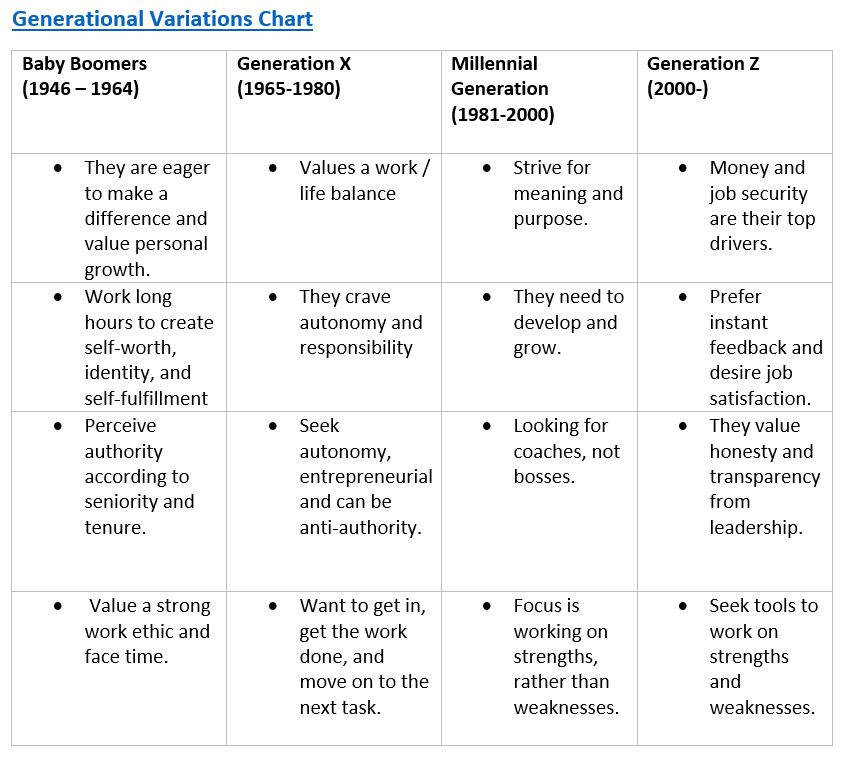How to Motivate a Multi-Generational Workforce

As a child of the eighties growing up in Britain, I used to watch Star Trek. Many would say a brave admission! The now iconic quote, “It’s life Jim, but not as we know it” is something I remember as if it was yesterday. This quote could have been speaking about new technology, amazing discoveries in science, and also about the changes in our work environment.
Today, multi-generations share the same work environment but differ in their goals and motivations. The key for any business leader is to find a way to get the best out of their team.
Some differences in the multi-generational workforce:

Some positives of a multi-generational workforce:
Now that we have established the differences between the multi-generational workforces, what are their strengths?
Lisa McQuerrey, writing for the online magazine Chron.com, says a business with a multi-generational workforce has a competitive advantage over a business that does not. Among the plusses, include a team with a wide range of skills and abilities. Younger employees are able to enrich the knowledge of older ones on how to use webcasting and the latest networking tools. Baby boomers and other senior employees have the experience of dealing with customers / clients that younger employees lack.
Wes Collins, Senior Director of Marketing at West Unified Communication Services, says businesses need to choose the best technology and innovation that fits their cultural makeup. Collins advises against firms rushing to implement the newest and most advanced tools that some team members will find a hindrance.
There are creative strategies that can help maximize the abilities of all members of a multi-generational workforce; among the most effective is reverse mentoring.
Reverse Mentoring utilizing the wide array of skills of the multi-generational workforce:
 Jack Welch, former CEO of General Electric, implemented reverse mentoring in 1999- pairing 500 senior and junior employees. Welch’s goal was for junior and senior employees to share knowledge about best practices and the latest technology. Today, General Electric’s youngest and brightest update seasoned team members on new trends and technologies.
Jack Welch, former CEO of General Electric, implemented reverse mentoring in 1999- pairing 500 senior and junior employees. Welch’s goal was for junior and senior employees to share knowledge about best practices and the latest technology. Today, General Electric’s youngest and brightest update seasoned team members on new trends and technologies.
Target and Cisco are among the largest firms that have followed Welch’s pioneering steps. These two firms operate in different industries, but they share a similar goal – to provide shared learning opportunities for employees from different backgrounds. Organizations also find reverse mentoring helps them meet organizational goals such as increasing millennial retention or creating a more inclusive culture. Today, goal setting is an effective strategy to motivate a multi-generational workforce. It satisfies millennial employees’ needs to develop and to grow; gives generation Z job satisfaction when meeting targets; and helps Baby Boomers pursue personal growth.
Goal Setting and its use in the modern work environment:
 Goal setting is a well -supported model discovered by John Locke in the 1960’s when John Locke discovered a connection between goal setting and employee performance. Locke also found that when companies set goals higher, employees work harder to achieve them.
Goal setting is a well -supported model discovered by John Locke in the 1960’s when John Locke discovered a connection between goal setting and employee performance. Locke also found that when companies set goals higher, employees work harder to achieve them.
Since the 1960’s, Locke Goal Setting Theory has received support from over 1,000, studies using a range of participants from blue collar workers to those working in research and development.
How employers can successfully use Goal Setting theory:
Kevin Johnston, writing for azcentral part of the USA Today Network recommends Goal Setting should follow the following guidelines:
- Clarity- make sure your employees have a clear idea what they are aiming for and set a deadline for the project
- Challenge- tasks or project difficulty needs to be evenly balanced- not too easy, but not impossible to achieve
- Commitment- ensuring employees are engaged enough to achieve their goals -a great way is to ask employees to set their own goals or targets
- Feedback- employers should hold periodic meetings with employees to provide encouragement and to speak about challenges
- Task Complexity– break down larger goals into smaller achievable benchmarks
The secret of motivating a multi-generational workforce
In today’s ever-changing corporate arena, changes happen at a rapid pace. There is greater versatility of skills and a growing heterogeneous workforce. The challenge for business leaders is how to get the best out of their employees by using the right motivational approach and tools that best fit the diverse makeup of their teams.
By: Jonathan Gordon
